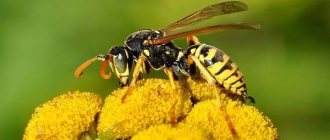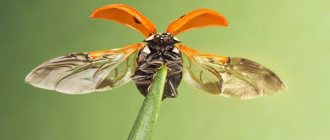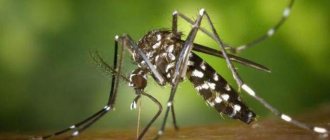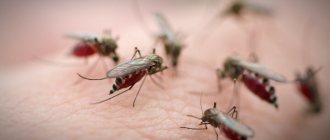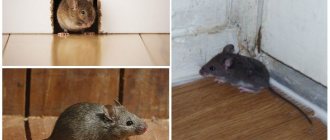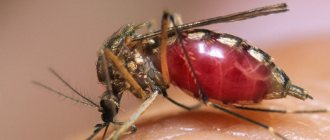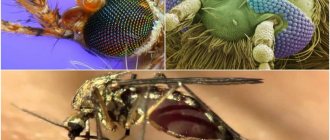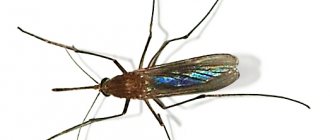Ants are a type of insect that is ubiquitous. These tiny creatures inhabit almost all corners of the planet, including permafrost zones and arid deserts.
A characteristic feature of the species is living only in a family environment ; insects cannot exist alone. The life of ants, its duration and characteristics depend on the caste of the individual.
Workers, queens, guards, and males can live in one family. Representatives of most species cannot change caste.
Also, the duration of an ant’s life depends on the size of the individual; the largest insects, as a rule, live especially long.
How long does he live?
The lifespan of ants in nature is determined, first of all, by species. How long an ant lives depends on what species the individual belongs to
.
Eg:
- Pharaoh ants. Insects belonging to this species are heat-loving and adapted to living only in human housing. The lifespan of queens of this species is nine months, workers - no more than two.
- Garden black ants. These insects prefer to settle in close proximity to human habitation, often in private homes. The lifespan of representatives of this species is three years, but in fact - no more than one year.
- Forest and meadow. These ants, as the name suggests, live in forests and meadows. Life expectancy is no more than five years, but due to natural factors such as predators and birds, the given periods can be significantly reduced. The life span of queens is longer than that of ants of other castes, since they are protected from external enemies.
- Tropical ants. These insects are called the longest-livers among all species. The queens of this group live more than twenty years, while the workers live about five to seven.
The lifespan of ants is directly determined by the action of external factors, which include enemies, predators, birds, as well as diseases and natural disasters.
Influence of various factors
Ants
The lifespan of insects is influenced by climatic factors, the amount of food, and living in artificially created conditions.
- Ants can theoretically live without food in an anthill for about 6 months. Because inside the structure of their nest there are numerous chambers with food supplies. . Insects feed on the juices of plants, berries, fruits, caterpillars, and dead beetles; they can only be left without food in artificially created conditions. In this case, the ants will die within 2 weeks.
- Insects also live in an apartment for a long time, unless a person declares a cruel war on them. However, this condition applies to “unexpected guests” with a full-fledged family. If artificial conditions for the existence of these insects are created, the insect lives without an anthill for no more than 3 months. If the house is not arranged accordingly, there is no hierarchical structure of "society".
- In countries with harsh climates, ants have to spend the winter and sleep for most of their lives - 9 months. Therefore, their total life expectancy for 3 years is barely equal to the life expectancy of representatives of tropical countries for 12 months.
How many paws
Regardless of what species these or those insects belong to, the number of legs in ants is unchanged and is three pairs. Depending on the location, each pair of legs of ants performs a strictly designated functional load.
The front one, for example, is intended for cleaning. The peculiar brushes located on this pair help the ant to clean its antennae, abdomen, and other legs.
The back pair of ant legs are equipped with special spines that allow the insect to climb smooth, vertical surfaces.
In addition, these spines help them in the fight against representatives of other species and are used to protect against external enemies.
Some species use their paws to move along the water surface, that is, for swimming.
How do ant colonies appear?
Have you ever wondered how many ants live in an anthill? And there could be about a million of them! But how does the colony manage to grow so large? Of course, there are several thousand species of ants on earth, and their anthill organization systems may be different, but usually the development of a colony follows this scenario.
- In an existing colony, the young female is not the only one fertilized by males.
- She becomes detached from her family and finds a new nest, leaving with a small number of workers. There she chews off her wings and remains to produce offspring for the rest of her days.
- Since the queen is fertilized once and for life, she begins to actively lay eggs, triggering the expansion of the colony.
- The eggs turn into larvae, which turn into pupae. Already 45-60 days after the eggs are laid, the first batch of workers appears, the number of which is continuously replenished.
A fertilized queen can build a colony from scratch, giving birth to the first workers and caring for them on her own. But to fight ants, it is important not only how many there are in the apartment, but also how long the ants live in the colony.
Structure
The structure of an ant can be characterized as a rigid frame, the functionality of which is to bind the insides of the ant. It is protected from external factors by a durable exoskeleton, often called the cuticle. The structure of the ant's body involves division into three main parts: stomach, chest, head.
The insect's stomach contains the digestive system, as well as organs that act as weapons of chemical defense. Representatives of certain groups are armed with poisonous stings. The muscles that provide mobility and strength to the legs are concentrated in the chest.
The ant's head is devoid of hearing and smell. It contains only sensitive antennae, which allow the individual to navigate in space, recognize objects, as well as complex eyes. Most species have extremely poor vision.
The length of an ant's body depends on the species of the ant. The length of the smallest ones, for example, pharaonic ones, is no more than two millimeters. There are also giant representatives of the species, the length of their abdomen often reaches three centimeters.
Uterus or queen
How long does a queen ant live? A question that is quite difficult to answer. Almost everything depends on the type of insect. There are some individuals who manage to live up to 25 years. In particular, the female woodworm lives to be so many years old. However, the most common ants in our region cannot boast of a long lifespan. Queens of this species live only 2 years, and only if conditions are favorable. Red queen ants (inhabitants of wildlife) can live up to 10 years.
At the same time, not everything depends on the weather and the amount of food. Worker ants can kill the queen in two cases:
- if she produces few offspring;
- became superfluous in the anthill.
Also, the insect community is characterized by the presence of several queens, which can later create their own colony, separating from the previous one. It is for this reason that if insects appear in the house, it is very difficult to get rid of them. Queens that live on farms, usually producing harvesters and wood ants, can live up to 20 or even 25 years.
Insect or not
You can determine whether an ant belongs to animals or insects by certain external signs. The presence of chitinous cover, six pairs of legs, as well as other structural features of the body classifies them as insects and arthropods.
Classification of ants is somewhat difficult , since there are a lot of hybrids, as well as species of lookalikes. However, scientists have identified about twenty subfamilies of the ant family, many individual species and subspecies.
Anthill structure
The “houses” of these insects are complex and have a surprisingly well-thought-out structure. More than a million individuals can be in it at the same time. The anthill has several exits, each of which is guarded by “soldiers,” as well as a large number of “production” premises.
- There is a “cow barn” - a chamber for keeping aphids (insects that ants breed and protect).
- Cemetery - a compartment for dead insects and various garbage.
- Barns are places for storing supplies. Moreover, there are several types of barns: for “grain” (plant seeds collected by the reapers are stored here) and for “meat”, where caterpillars, flies or other insects brought are stored.
- Place for the uterus. The queen of the colony lives in her own room, her main task is laying eggs. She is cared for by special working individuals.
- Finally, there are chambers with offspring, where larvae, pupae, eggs and workers monitoring them are located.
Indeed, the structure of the insect colony’s home is striking in its logic.
Lifestyle
The lifestyle of ants also varies according to species and caste.
The following features of the life of these tiny insects can be distinguished::
- Nutrition. The food preferences of individual species can vary significantly. Most arthropods feed on plant and animal foods. For growth and development, ants need protein, which they get by eating insects and atrophic eggs. Those living on the territory of a person’s home or in its immediate vicinity consume traditional food products and food waste.
Arthropods also need carbohydrates, which they consume through a sweet liquid secreted by aphids, dew containing plant sugars. Individual colonies grow mushroom plantations on the territory of anthills.
Most ants living in areas with moderate or severe climatic conditions make abundant reserves for the cold period, which consist of insects, grains, roots
Separately, we need to consider how ants live on the territory of the colony, that is, the anthill.
There is a clear hierarchy according to which individual members of the castes perform the following duties:
- Reapers. Their duties include collecting plant materials such as grains.
- Gravediggers. As the name suggests, the duties of these workers include the delivery of deceased brothers to the conditions of special chambers of the anthill.
- Engineers, builders. These insects not only build housing, but also arrange it.
- Soldiers. Soldiers protect housing from attacks by other insects or other natural enemies.
- Doctors. They are engaged in the treatment of relatives.
- Nurses. The responsibilities of these insects include looking after larvae and eggs. In case of danger, it is these workers who quickly deliver the larvae to safe places.
However, not all arthropods live in large colonies. There are some arthropods that live in relatively small groups.
Caste division
ant castes
Quite a lot is known about how ants live. All species are divided into three castes:
- females
- males
- workers
Workers represent the most numerous class of the anthill population. On average they live from 1 to 3 years. Theoretically, they can live twice as long, but this, as a rule, does not happen. Working ants, which due to their duties are forced to constantly leave the anthill, are exposed to various dangers - they often become victims of predators, die in fights with other ants, are crushed by large animals, etc. The same worker ants that constantly work inside the anthill - for example, caring for eggs or monitoring the arrangement of the “home” - are also given a shorter life span.
“The fate of an ant is determined from birth, at the genetic level; and cannot change throughout life.”
Male ants live shorter than all other inhabitants of the anthill. Often only a few weeks. Having fertilized the females, they completely fulfill the task assigned to them. Most often, the males are eaten by the worker ants of their native anthill; in other cases, the “continuers of the family” simply die of hunger - since they are not able to get food.
The female, or queen, of the anthill is the founder and most important member of the community. She is able to live much longer than her “subjects”. According to some reports, female ants live up to 18-20 years! Moreover, this does not take into account the life time in the larval stage.
What does it look like
The appearance of individual ants depends on the caste and species.
For example, this is what representatives of some groups look like:
- Pharaonic. The length of the body of a representative of the working caste is no more than two millimeters, the color of the abdomen varies depending on age and can be reddish, brown or yellow. Females and males are distinguished by their larger sizes - about four millimeters and black body color.
- Red forest ones. Today, the number of this group has decreased significantly, which is due to a reduction in forest resources. Red forest ants are relatively large in size, ten to twelve millimeters. They are characterized by a red color on the abdomen and black on the chest.
- Black. Distributed throughout the country, they are classified as agricultural pests, which is due to the specific nature of their habitat and life activity. The body size is five millimeters, the body color is brown or black.
- Myrmica red. The habitat covers the territories of Siberia and the Urals. Ants of this group settle near agricultural lands, which is due to the characteristic features of their life activity - they consider insect pests, for example, aphids, as food sources. Body length varies from five to seven millimeters. Color depends on gender, females are red, males are black.
- Blood red. This group of arthropods is reddish in color and medium in size - about eight to ten millimeters in length. A distinctive feature is the specificity of life activity. Anthills raid the anthills of other colonies, capturing larvae and eggs. Further, the individuals obtained in this way are used as workers - slaves.
The external features of arthropods also depend on caste . For example, guards or predators have powerful jaws, with which the ant defends its own home or raids representatives of other colonies.
Workers are small in size and have a short life expectancy. The uteri are extremely large in size, significantly exceeding the size of representatives of other castes. The life expectancy of female queens is also much longer than that of their relatives.
Lifespan of different types of ants
According to the species, there are differences regarding the lifespan of an ant; there are several factors that influence this; let’s consider the main ones.
Red Forest - Formica rufa
This type of insect is also called a mixed forest orderly, since the inhabitants of a large anthill have the opportunity to cleanse an entire hectare of forest from pests of all types. Throughout the day, hard workers are able to collect several thousand pest pupae, which are then used as complementary food for the larvae.
Speaking about the life expectancy of red forest ants, according to genetic factors, it is limited to five years, but in life they die much earlier than nature gives them. The reason for this is that they turn into prey for birds.
It is also worth noting that the males even die a month after completing their main function. The female has the opportunity to become a long-liver if she constantly stays in the anthill.
Meadow - Formica pratensis/Messor Structor
This species is also called reapers; they prefer meadows and forest edges as their habitat. Females leave their place of residence only twice in one season, the purpose of which is fertilization. Speaking of life expectancy, it coincides with the previous type of insect.
Ants that rarely leave the comfort of their anthill have a longer life span compared to those that are forced to do so often. This is why working individuals die faster; the main cause of death is an attack by a predator, as well as a high risk of injury.
Pharaonic - Monomorium pharaonis
The pharaoh ant is one of the main domestic pests that was introduced from hot habitats. He moves in and lives in the house. Inside apartments, this species does not build an anthill, but chooses a separate cavity or niche as a home.
If pharaonic individuals settle in apartment buildings, their colony can reach several thousand representatives, each of them belonging to the same family.
This type of insect is characterized by the shortest life cycle. The female can live on average no more than nine months, breeding males only 20 days, and the worker caste no more than two months.
But despite this, over such a short period of existence, ants are able to reproduce at least 30 thousand individuals - this is done due to the fact that the nest of the family includes a large number of queens.
Black garden - Lasius niger
Black garden insects choose the ground as their residence, and in some cases, people’s houses. Their lifespan, according to genetic factors, is determined to be 3 years, but in real life their colony is renewed within just 1 year of existence.
General information about ants.
These insects belong to the family Formicidae, a group of Hymenoptera of the suborder Stalk-bellied. This suborder also includes other flying insects (bees, bumblebees, wasps, etc.); As is known, during the breeding season, ants grow wings for a short time, facilitating settlement and finding a partner for fertilization.
The family has, according to some sources, about 7,000 species, according to others – about 12,000 species existing on the entire planet. These are heat-loving creatures, although they are capable of living in cold conditions: the further north the latitude, the smaller the size of the individuals. Ants make up 1/5 of all existing terrestrial living creatures; they are distinguished by the large number and diversity of phenotypic characteristics.
The climatic conditions of Russia and the republics of the former Soviet Union are home to 220-300 species of these creatures; the further north, the fewer of them: for example, if more than 160 species of arthropods live in the Caucasus, then at the level of the Arkhangelsk region there are no more than 20-24.
Formicides play an important role in ensuring the life of the entire biosphere:
Attention! In Russian conditions, several types of representatives of Formicides are known that can cause harm to a person or his activity.
The main ones include:
Below we will discuss the main features of the life of these and other harmful ants.
Conquerors of the globe
These insects are the real conquerors of the Earth. Today, almost 14,000 species of ants live in nature. Of these, several hundred subspecies live on Russian territory.
The number of representatives of the ant population is innumerable. They always live in families or, as they are also called, colonies. Individuals are simply not capable of existing separately. Numerous ant colonies are distributed throughout the world. They can be found everywhere:
- in forests;
- in the steppes;
- in deserts;
- on ordinary city and village streets.
Different types of ants can be found in different habitats
They even reached the permafrost zone. Most subspecies live in natural conditions, but there are also those who settle in human dwellings - houses and apartments.
The only corners of the planet where ants have not yet settled remain:
- Antarctica;
- Greenland;
- some oceanic islands.
In this video you will learn the life expectancy of different types of ants:
Why do ants live in colonies?
New facts about these creatures are still emerging, despite the fact that ants have been known to mankind since ancient times. Only recently have the ancient ancestors of these unusual creatures been identified. We all know what an ant looks like. The structure of an ant resembles a wasp. This is no accident. It was not only the study of the anatomy of these insects that made it possible to identify such a relationship. Many fossils of early forms have now been discovered that have even more in common with wasps. Photos of these ancient creatures sealed in amber confirm their similarity. Ant venom and strong jaws were inherited by modern ants from their ancient ancestors.
Huge bulldog ants have retained the sting that they inherited from their distant ancestors. This view is archaic. An ant bite is extremely painful. Most species of these insects have lost not only their stings, but also their wings in order to live on and under the surface of the earth. It was from the ancient wasps that they adopted the principle of community life, but over time their colonies acquired a more complex structure. Insects can communicate with each other. They leave trails of pheromones that help them find victims. Such communication is effective and worthwhile. Studying the substances that these insects secrete has made it possible to find out how ants find their way home. Pheromones help to identify strangers and drive them away from the anthill. Insects communicate with each other using rhythmic, low-frequency tapping sounds. This allows you to determine whether the encountered individual is a friend or an enemy. Some species of these insects use abdominal vibration in the process of communication.
